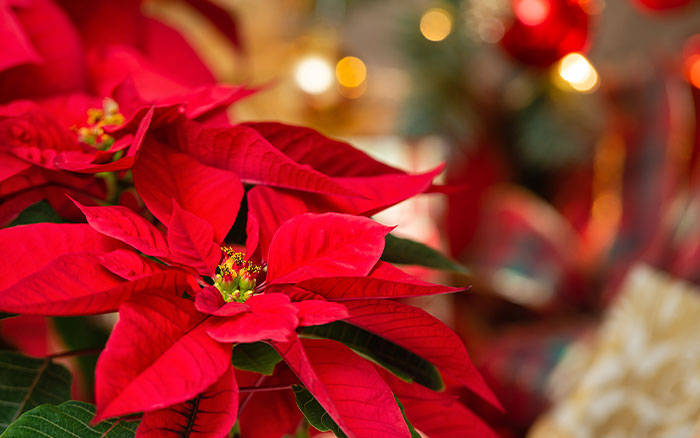Christmas is a time for giving and plants that flower at this time of year make wonderful presents. So, why not consider giving a plant to a loved one or friend, or yourself?
Poinsettia
Ask somebody what plant best represents Christmas and the answer will usually be ‘Poinsettia’. And for good reason! The leaves turn a cheerful shade of deep red during the winter, making the perfect choice to celebrate the season. Produced en masse and available in many supermarkets and Garden Centres, many people treat them as disposable annuals.
However, if you master the knack of keeping them alive post-Christmas, it’s possible to keep your poinsettia for many years. There’s also an art to helping the plant’s leaves turn red again the following winter!
The first thing to remember about Poinsettias is they’re from Mexico, where they’re exposed to a completely different climate.

So, avoid buying plants with wilting leaves. This usually means they’ve been stored in too cold conditions, and they won’t last. Keep the plant in a draught-free spot in the house, ideally in indirect light and don’t overwater. Wait until the surface of the compost has dried out before watering. Mist the leaves regularly as Poinsettias love a humid environment, and this should keep the leaves red for longer.
Come the New Year start to feed the plant once a month with a high potassium feed such as tomato food. In April trim the plant drastically to about 10cm tall and keep at temperatures around 15C out of direct sunlight.
For red leaves next December, you’ll need to make a diary note to put it into a dark cupboard for 12 hours daily from November. Keep the temperature at 18C with no exposure to light at all during those 12 hours.
Christmas Cactus (Shlumbergera)
These types of cacti start to flower in November and continue through to January. As a result, they make great Christmas gifts. Flower colours range from bright red to purple and are a lovely way of brightening a room this season.
In the wild the Christmas cactus can be found growing in tropical rainforests attached to trees. In your home, place them out of direct sunlight and misted regularly, or placed on a kitchen or bathroom windowsill.
It’s easy to get them to flower yearly provided you give them two periods of rest in the new year. Once directly after flowering and the other in autumn. Simply move them to a cool room and water infrequently for a few weeks.
Give them this treatment and you should have many Christmases of flowering Christmas cacti.

Hippeastrum/Amaryllis
Hippeastrum (or amaryllis as many people call them) bring a touch of warmth to the home during the winter months. For Christmas colours ‘Royal Velvet’ for dark red blooms, ‘Carmen’ for rich crimson colour or ‘Liberty’ for phone-box red!
In order to have them flower in time for Christmas the bulbs need to be potted up in October. Plant them with two-thirds of the bulb protruding from the top of the compost to stop it from rotting. Water when first potting up and then only sparingly until the flower shoot appears.

Keep the pot in a warm part of the house in indirect sunlight until the flower shoot appears. At this point, the pot should be moved to a cooler room and watered regularly. It’s helpful to turn the pot regularly as this will help stop the flower spike from leaning towards the light.
When the flower opens feed the plant weekly with a high-potassium feed. Continue to regularly water the bulb until the leaves start to die down. This is important if you want the bulb to flower again. At this stage, the bulb will be building up its food reserves for next year’s flowering.
Stop feeding and watering when the leaves start to wilt and turn yellow. Then leave the bulb in its container in this dormant state. Place it in a cool, dry place until the autumn when you can start watering the bulb again.
Holly
Moving outside the house into the garden, why not plant a holly tree, another plant that’s synonymous with Christmas? They’re easy to grow and their evergreen leaves provide year-round interest. They have the bonus of bright red berries at Christmas if you choose a self-fertile variety like ‘J.C. van Tol’. They grow well in full sun or part shade and are not fussy about soil type provided it’s well-drained. There are varieties of all different heights too ranging from compact 90cm to a whopping 6 metres tall!

Cotoneaster
Another evergreen outdoor plant that’s quick and easy to grow and full of orange berries when mature is Cotoneaster franchettii. The underside of its leaves is an attractive silver which looks particularly effective gently blowing in the breeze. The long-lasting berries are an excellent choice for adding to seasonal wreaths or bringing into the house to add to festive table decorations. They are also a great wildlife support in the garden through the winter.

Really get into the spirit of the festive season with these beautiful Christmas plants for your garden, home, or gifts.

Leave A Comment